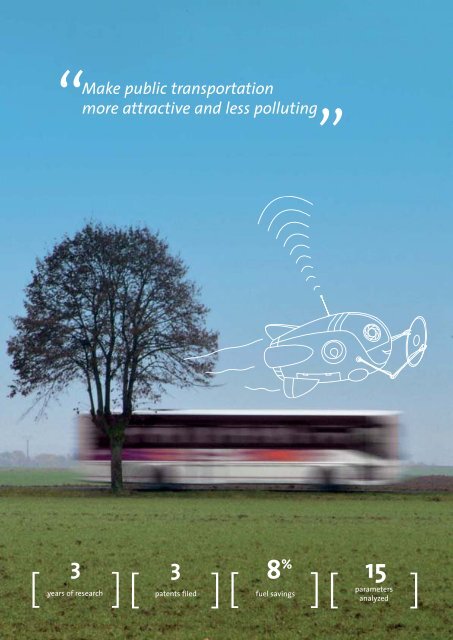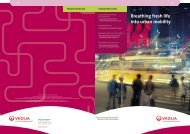Make public transportation more attractive and less polluting - Veolia ...
Make public transportation more attractive and less polluting - Veolia ...
Make public transportation more attractive and less polluting - Veolia ...
You also want an ePaper? Increase the reach of your titles
YUMPU automatically turns print PDFs into web optimized ePapers that Google loves.
“<br />
<strong>Make</strong> <strong>public</strong> <strong>transportation</strong><br />
<strong>more</strong> <strong>attractive</strong> <strong>and</strong> <strong>less</strong> <strong>polluting</strong><br />
”<br />
3<br />
[ ]<br />
3<br />
[ ]<br />
8 %<br />
[ ]<br />
years of research patents filed fuel savings<br />
15<br />
[ ]<br />
parameters<br />
analyzed
NEW TECHNOLOGY<br />
no. 12<br />
SEE THIS<br />
SUCCESS STORY<br />
ON DVD<br />
[ CHALLENGE ]<br />
[ RESULT<br />
]<br />
[ INNOVATION ]<br />
Operational contact: Laurent Briant<br />
lbriant@cityway.fr<br />
Eco-driving Assistant<br />
A simple, effective system<br />
Optimize the way in which vehicles operated by <strong>Veolia</strong><br />
Transdev are driven, to enhance passenger comfort<br />
<strong>and</strong> cut fuel consumption <strong>and</strong> carbon emissions.<br />
A driver assistance system: a display that lets drivers<br />
know in real time whether or not they are driving<br />
appropriately.<br />
An onboard smart device with sensors,<br />
computer <strong>and</strong> interface using colored lights.<br />
A bus driver brakes 700 times, spends over an hour <strong>and</strong> a<br />
half braking, starts up <strong>more</strong> than 200 times <strong>and</strong> makes as<br />
many as 1,000 turns of the wheel in just one day of driving a<br />
city route! It is easy to imagine how these repeated actions<br />
impact passenger comfort, fuel consumption <strong>and</strong> vehicle maintenance,<br />
especially when seen in the context of the <strong>more</strong> than<br />
30,000 coaches <strong>and</strong> buses operated worldwide by <strong>Veolia</strong> Transdev.<br />
Thanks to the Eco-driving Assistant developed by <strong>Veolia</strong>, it is now<br />
possible to optimize coach <strong>and</strong> bus driving in a simple, intuitive<br />
<strong>and</strong> non-stressful way for drivers. By analyzing a set of data, the<br />
Eco-driving Assistant provides drivers with real-time information<br />
to improve their driving profile. Hop on board <strong>and</strong> find out <strong>more</strong><br />
about this multi-application system, introduced in the Côtesd'Armor<br />
region in north-western France.<br />
><br />
Eco-driving Assistant<br />
15
[ PUBLIC TRANSPORTATION OF TOMORROW]<br />
◊Heading toward sustainable <strong>transportation</strong><br />
Smoother driving<br />
for <strong>more</strong> pleasant<br />
<strong>public</strong> transit<br />
V<br />
Eco-driving Assistant<br />
eolia has always sought to<br />
minimize its environmental impact, a<br />
concern that has prompted the use of<br />
exclusive assessment tools such as<br />
the Eco-Efficient Travel Indicator*. It<br />
has also yielded tangible, quantifiable<br />
results, such as 3,5 million avoided<br />
tons of carbon equivalent in 2010.<br />
What <strong>more</strong> can be done?<br />
Researchers have found fuel consumption<br />
variations of nearly 35 %<br />
between two radically different<br />
driving styles — very environmentally<br />
friendly versus very sporty — not to<br />
mention the impact on passenger<br />
comfort <strong>and</strong> ve-hicle maintenance…<br />
This clear-cut opportunity for<br />
improvement gave rise to the idea of<br />
creating an operational driving assistance<br />
device. The system had to meet<br />
two requirements: be easy to use,<br />
*This indicator measures <strong>public</strong> <strong>transportation</strong> performance per passenger compared with private cars, looking at carbon emissions avoided,<br />
congestion reduction, liters of fuel saved, etc.
so that drivers would be happy to use<br />
it, <strong>and</strong> be affordable to ensure that<br />
operators <strong>and</strong> municipalities would<br />
adopt it.<br />
Innovation-bound<br />
driving support<br />
To get the show on the road,researchers<br />
designed the Eco-driving assistance<br />
system around four components:<br />
• a panel of sensors throughout the<br />
vehicle;<br />
• a st<strong>and</strong>ard Bus-FMS (Fleet Management<br />
System) interface for all vehicle<br />
types that transmits information<br />
from the sensors;<br />
• an onboard computer;<br />
• a "Man-Machine Interface" with<br />
indicator lights developed especially<br />
for the system.<br />
Using prerecorded algorithms, the<br />
Eco-driving Assistant can process a<br />
range of data simultaneously, including<br />
[<br />
ECO-DRIVING ASSISTANT:<br />
]<br />
USER GUIDELINES<br />
RPM<br />
A DRIVING ASSISTANCE<br />
SYSTEM EMPLOYING:<br />
• Real-time analysis of driving parameters<br />
• Calculation of driving quality<br />
• Information transmitted to the driver<br />
ONBOARD COMPUTER<br />
INTERFACE<br />
GEAR SELECTION<br />
engine speed (rpm), gear selection,<br />
fuel consumption, speed <strong>and</strong> acceleration.<br />
This enables it to model buses’<br />
optimal performance in real time<br />
<strong>and</strong> define reference thresholds<br />
based on the speed limits in force.<br />
The man-machine interface can then<br />
send a simple, intuitive signal to the<br />
driver using a system of colored<br />
lights. When they are green, it means<br />
the driver is controlling his speed <strong>and</strong><br />
acceleration appropriately.<br />
If he is traveling too fast or braking<br />
too hard, the green lights disappear<br />
<strong>and</strong> red ones come on <strong>and</strong> may flash.<br />
This interface was developed in conjunction<br />
with ergonomists, trainers<br />
<strong>and</strong> drivers.<br />
All components were tested on a<br />
simulator before being tried out on a<br />
vehicle.<br />
VEHICLE TYPE<br />
Comfortable<br />
Smooth driving<br />
5 types of driving<br />
Fuel savings of up to 8%<br />
Field observations combined with<br />
simulations suggest the assistant<br />
will be a success. The Côtes-d'Armor<br />
(CAT22) interurban system in Saint-<br />
Brieuc has already reported savings<br />
of 4 to 5 %, just by having the display<br />
on board! The result is <strong>more</strong> economical,<br />
comfortable driving <strong>and</strong> <strong>less</strong><br />
stress on the vehicle, significantly<br />
improving the appeal of city <strong>and</strong><br />
regional <strong>public</strong> transit.<br />
Looking at the numerical data, simulations<br />
suggest fuel savings of 8 % for<br />
the Eco-driving Assistant if supplemented<br />
by optimized training for<br />
drivers.<br />
For <strong>Veolia</strong> Transdev, with a fleet of<br />
<strong>more</strong> than 30,000 coaches <strong>and</strong> buses<br />
around the world, it is a promising innovation.<br />
In 2011, the Eco-driving<br />
Assistant will be trialed in European<br />
<strong>and</strong> US cities including Argenteuil<br />
<strong>and</strong> Saint-Étienne in France, Haagl<strong>and</strong>en<br />
Jerky driving<br />
Sporty driving<br />
Uncomfortable<br />
VISUAL<br />
DISPLAY UNIT<br />
1 type<br />
of excessive speed<br />
><br />
Eco-driving Assistant<br />
17
[ ]<br />
THE ANGO PROJECT:<br />
AN ADVANCED DRIVING<br />
ASSISTANCE SYSTEM<br />
The ANGO research project aims<br />
to go even farther in modeling<br />
optimal driving.<br />
Unlike the Eco-driving Assistant,<br />
which characterizes driving style,<br />
the ANGO project aims to further<br />
optimize driving by integrating<br />
vehicle operating parameters<br />
such as route topography, theoretical<br />
timetables <strong>and</strong> <strong>more</strong>…<br />
It applies solely to bus-lane <strong>public</strong><br />
transit, that is systems that use a<br />
reserved lane or space such as<br />
bus rapid transit (BRT).<br />
It is currently being tested in<br />
Rouen, France.<br />
Eco-driving Assistant<br />
in the Netherl<strong>and</strong>s, Pforzheim in Germany<br />
<strong>and</strong> New Orleans in the United<br />
States.<br />
In France, the cities of Beauvais, Le<br />
Mans, Nice, St Brieuc, Toulouse <strong>and</strong><br />
Tours already use this device for their<br />
interurban transit systems.<br />
This innovative device is manufactured<br />
<strong>and</strong> marketed by Cityway, a<br />
<strong>Veolia</strong> Transdev subsidiary specializing<br />
in products <strong>and</strong> services designed<br />
to facilitate mobility.<br />
Another reason operators are so<br />
interested in the Eco-driving Assistant<br />
is that it is a valuable tracking<br />
tool, both for quantifying each vehicle’s<br />
exhaust emissions <strong>and</strong> monitoring<br />
the driving statistics of drivers.
[<br />
“THE MOST USER-FRIENDLY SOLUTIONS ]<br />
ARE OFTEN THE HARDEST TO DEVISE.”<br />
How much time did it take<br />
to develop this innovation?<br />
How did you get financing for<br />
the innovation?<br />
The Eco-driving Assistant project<br />
was developed using <strong>Veolia</strong><br />
Transdev own equity. Moreover,<br />
a project dubbed ANGO, involving<br />
a consortium of five partners<br />
(<strong>Veolia</strong> Transdev, Irisbus,<br />
Siemens TS, INRETS <strong>and</strong><br />
LCPC/LIVIC) <strong>and</strong> led by <strong>Veolia</strong><br />
Environnement’s R&I, aims to<br />
develop an advanced driving<br />
assistance solution for bus rapid<br />
transit systems.<br />
◊3 questions for Emmanuel de Verdalle,<br />
head of the Eco-driving Assistant Project<br />
The ground <strong>transportation</strong><br />
research & innovation program<br />
PREDIT (Programme de recherche,<br />
d’expérimentation et d’innovation<br />
dans les transports terrestres) is<br />
providing 30 % of the financing<br />
for the ANGO project.<br />
It was instigated <strong>and</strong> implemented<br />
in collab-oration with<br />
the French research, <strong>transportation</strong>,<br />
environment <strong>and</strong> industry<br />
ministries <strong>and</strong> other institutional<br />
stakeholders*. PREDIT aims to<br />
promote the emergence of <strong>more</strong><br />
cost-effective, accessible, safer<br />
<strong>and</strong> <strong>more</strong> energy-efficient <strong>transportation</strong><br />
systems. It particularly<br />
focuses on reducing greenhouse<br />
gas emissions.<br />
How do you see the Eco-driving<br />
Assistant’s future?<br />
Transit authorities <strong>and</strong> operators<br />
want simple, ready-to-go<br />
<strong>transportation</strong> innovations. Yet<br />
the most user-friendly solutions<br />
are often the hardest to devise.<br />
But we delivered. The Eco-driving<br />
Assistant is very affordable<br />
<strong>and</strong> offers an array of driving<br />
improvements: lower fuel consumption<br />
<strong>and</strong> emissions, of<br />
course, but also tracking<br />
for oper-ators <strong>and</strong> benefits for<br />
drivers <strong>and</strong> passengers.<br />
Now we are going to test it on a<br />
wider variety of routes <strong>and</strong><br />
applications — highways, school<br />
buses, coaches, etc. — to better<br />
assess what it has to offer<br />
in each context. It is entirely<br />
conceivable that the Eco-driving<br />
Assistant will eventually be<br />
deployed on all vehicle types.<br />
*France’s environment <strong>and</strong> energy management agency (ADEME), OSEO, a <strong>public</strong> organization to support innovation <strong>and</strong> growth,<br />
<strong>and</strong> the French National Research Agency (ANR).<br />
Eco-driving Assistant<br />
19












